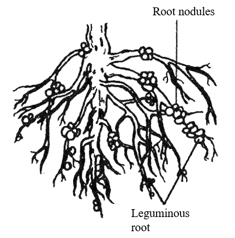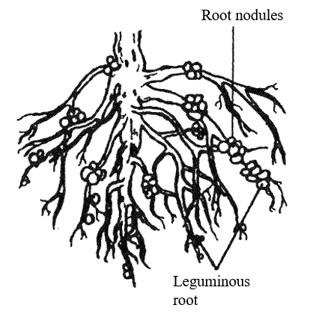Bacteria
Important Questions on Bacteria
Observe the diagram and answer the following questions. Give examples of leguminous plants and the bacteria that live in association with it.

Observe the diagram and answer the following questions. How can root nodules advantageous for plants?

Describe the harmful activities of bacteria.
Bacteria help in decomposition as well as putrefaction. Explain the role of bacteria with reference to these processes.
Match the following columns:
| Column I | Column II |
| A. Terramycin | 1. Bacillus subtilis |
| B. Griseofulvin | 2. Aspergillus flavus |
| C.Neomycin | 3. Streptomyces fradiae |
| D.Flavicin | 4. Claviceps purpurea |
| E. Bacitracin | 5. Streptomyces rimosus |
| F. Ergotamines | 6. Penicillium griseofulvum. |
What is the name of the disease in plants that is caused by Xanthomonas oryzae. Is it leaf blight of rice or rusting leaves of rice?
Anaerobic decomposition is called putrefaction.
Vaccines have only killed forms of bacteria.
Concentrated solutions cause _____ in cells of microorganisms.
| bursting | lysis | shrinkage | growth | conjugation |
_____ is a lactic acid bacteria.(Lactobacillus/ Streptococcus/Staphylococcus)
Milk is converted into lactic acid during the formation of curd.
Which of the following is a correct pair of bacterial disease and its causal agent?
I. Citrus canker — Xanthomonas citri.
II. Tundu of wheat — Corynebacterium tritici.
III. Blight of rice — Xanthomonas oryzae.
IV. Angular leaf spot of cotton — X. malvacearum.
V. Anthrax of cattle — Bacillus anthracis.
VI. Whooping cough — Bordetella pertussis.
Bacteria are known to increase the fertility of soil through different processes that help the plants to absorb nitrogen. Given below are few statements regarding the processes.
Choose the incorrect ones.
A. Denitrifying bacteria are capable of transforming nitrates to nitrogen.
B. Rhizobium and Azotobacter are ammonifying bacteria.
C. Nitrification converts ammonium compounds into nitrites and nitrates.
D. Nitrobacter is a nitrogen-fixing bacteria.
Given below are few statements about the antibiotics obtained from microorganisms. Read them carefully and mark the option containing the correct one(s).
A. Antibiotics do not work against viruses.
B. All the antibiotics are obtained from bacteria.
C. Ephedrine and flavicin are extracted from Streptomyces sp.
D. Antibiotics kill or retard the growth of other microbes.
How do different types of bacteria are related to soil fertility?
The role of bacteria in industries is widespread. Justify.
A method of preservation was suggested by Louis Pasteur. Which is this method? Explain
Define ammonification and nitrification.
What is a vaccine? Can it be obtained from bacteria?
Which disease in plants is caused by Pseudomonas solanacearum.

